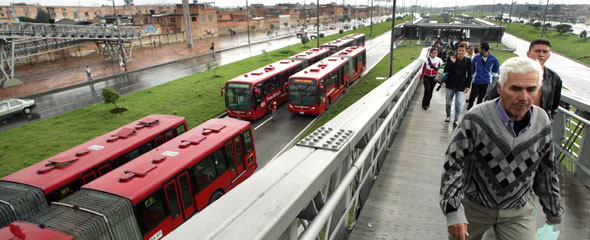
Anyone who has visited Bogotá in recent years will have seen them, those big red articulated buses that seem to dominate the streets. At first, this public transport system may be a little intimidating so here are a few tips to get you started.
Colombia Travel Agent – Mantaraya Travel
First, a little bit about this system. Transmilenio’s first routes were set up at the beginning of this decade and were based on an existing transport system in Curitiba, Brazil. Bogotá developed this system to fit a much larger city and has earned much credit and attention from other cities around the word.
Transmilenio consists of two different sections. The first are the articulated red buses that have their own lanes and transport people between main hubs which are usually located at the city’s extremes. There are the so called ‘Ruta Facil’ (easy route) that stop at all the stations between two major hubs, and then there are express services that only stop at particular stations. Make sure to pick the right one because you could be either spending way too much time on your trip, or watching your stop fly by when you were expecting to get out.
The second part consists of smaller, green buses. These are called ‘Alimentadores’ or ‘feeders’ and take people to the main hubs and a few other important stations. You don’t pay to use an alimentador, as you can buy your ticket upon arriving at the main hub. One ride costs 1.500 pesos, no matter where you go.
Now, what to do and what not to do?
1. First of all, before using Transmilenio it should become a habit to visit www.transmilenio.gov in order to plan your trip. The system really is straight forward once you know it, but you do first have to get familiar with all the lines and numbers. Also, Saturdays, Sundays and holidays have different schedules so be aware.
2. The express services are easy to recognize as their line numbers always use double digits. The Ruta Facil always uses single digits or just mentions that it is a Ruta Facil. For example, let’s analyze a bus. One of transmilenio’s main routes leads to the Portal de la 80 hub in the north-west of the city. Any bus that is headed for this hub will have the letter ‘D’ in its line number. D3 will stop at any of the stations that the bus passes before arriving at the hub, while D20 will only stop at particular stations. The same would go for D21 or D50. It’s really quite simple once you know.
3. When you are about to board a bus, remember to be polite and get in line. The platforms have clear yellow arrows that indicate where to form lines. Each bus has three different entrances and there’ll be two lines for each. That makes six in total. Once the bus arrives, make sure that no one can get past you because there will certainly be people trying to do so.
4. Getting into the bus can be a minor war. Do not think about others, just about yourself. Remember that everybody else is doing the same and nobody is going to offer you a seat. Be fast, try to get a seat, and try not to hurt anyone in the process.
5. Use a red seat! The blue seats are only for the elderly, pregnant women, disabled and people with young children. When you’re on a red seat, there is no obligation to give it up for someone who needs it more as they have the right to use the blue seats.
6. Be very careful. While Transmilenio is relatively safe, there will always be people trying to take advantage of travelers not paying attention and pickpocketing unfortunately still occurs. Keep your hands on your pockets or better, make sure that your possessions are well covered and hard to reach.
7. While some rules should be followed, one that really doesn’t need following is the ‘don’t stand near the doors’ rule. When the bus is very full and you’re trying to get in, you just have no choice. The doors turn inwards and as long as you turn along with the door (keep your back towards the door), nothing bad can happen.
8. Some buses have electronic systems that tell you which stop is next, but many don’t. When you plan your trip, always check which station (or two stations) your bus is scheduled to stop at before arriving at yours. When the bus is crowded, get up a little in advance to get close to a door. Because getting out, just like getting in, can at times be a tough task.
All in all, Transmilenio is a great system and does a good job to replace the absent metro system. The only downside, and something all Bogotanos complain about, is the fact that buses tend to be very, very full. When you manage to get a seat, be very happy. When you don’t, just remember that your trip definitely would have taken longer if this system didn’t exist!

